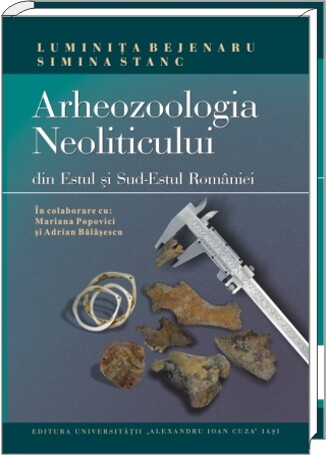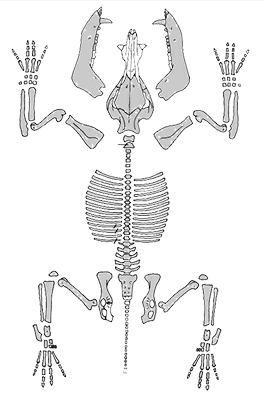Code: PN-II-RU-TE-2011-3-0146 no. 55/05.10.2011
Name of PN II Program: Human Resources (RU)
Subprogram: Research projects to stimulate the formation of young independent research teams (TE)
Contract value: 750000 lei
Contract duration: 36 months (5.10.2011 – 4.10.2014)
Authority: Executive Unit for Financing Higher Education, Research, Development and Innovation (UEFISCDI)
Impact, relevance, applications of the project
The project studies the origin of the domestic pig in Romania, using the morphological variability at the skeleton level and the ancient DNA; we aim to answer to the question whether the Romanian territory contained domestication centres for the boar, during the Neolithic period. These data will be correlated with the international ones concerning the origin of the domestic pig and it’s spreading on the European territory, thus helping to enlarge the database for the wild and domestic pig from the Neolithic up to the medieval age.
The results of this research will penetrate the international scientific flux at congresses, international conferences etc., and will be published in revues as AHCI or ERIH, they will appear in a book.
The development of the bioarchaeological research in Romania, including the newest research methods in archaeology. The usage of new methods and research equipments (from the Archaeogenetics laboratory of the Biology Faculty of “Al.I.Cuza” University, Iasi), as well as for the conservation and protection of the archaeological and biological heritage.
The development of the interdisciplinary character in archaeology (archaeozoology, archaeometry, anthropology, archaeogenetics), in order to adopt the international evaluation criteria for the quality and performances of the archaeological research – directly promoting the enhancement of the number of international collaborations.
The consolidation of the bioarchaeology’s role through the promotion and dissemination of the research results in specialized media (participation at conferences and international congresses, specializations in archaeogenetics laboratories, participation at workshops etc.), but also through their spreading in order to develop the science – society interface. The integration of researchers coming from abroad in the national system of research and development.
The formation and interdisciplinary specialization in bioarchaeology; the team also contains three post – Ph.D. researchers and a Ph.D position student.
The integration of the Archaeozoology and Archaeogenetics Laboratories from Romania in the international research and interdisciplinary formation structures. One has already anticipated the development of existing partnerships with other similar institutions: University of Groningen (Holland), University of Liege (Belgium), CNRS-Paris (France), AberdeenUniversity, DurhamUniversity (Great Britain).
The results of our project will be included in academicals courses and in practical programs, thus increasing the practical field for the interdisciplinary dimensions of the didactic process.
Scientific context and motivation
The beginning of the modern civilization has its roots in the Neolithic Revolution, which started 11000 years ago, in the Middle East. In the last three decades, it has made sustained efforts all over the world in order to know the causes which determined the Neolithic Revolution. The research was focused mainly on the Middle East, but lately some complex investigations were initiated over several other geographic areas. Thus, in Central and South-eastern Europe there are several programs of archaeological research in course, aiming to study the passage to Neolithic and the evolution of the Neolithic cultures. In these programs, the contribution of the archaeozoology is very important. Recent paleogenetics analysis has demonstrated that there are two or more origins of several domestic animals (the cow, the sheep, the goat and the pig), which come from two or more ancient species or sub-species (Zeder, 2008).
One must not forget that, on contrary to other domestic animals whose wild ancestors live in other areas than Europe, only the cow and the pig could have been locally domesticated in the European space, considering that in Neolithic, one could find here the wild boar and the aurochs.
The old morphology and genetics data sustain that the pig’s domestication was realized in few locations. New archaeogenetics data (using the study of mitochondrial DNA from wild boar and domestic pig) indicate several centres of domestication along Eurasia and Europe; thus, the origin of the pig could be localized in Malaysia and Sumatra, Borneo and Java islands. The wild boar had spread from these islands to India and Pakistan, and on the other hand, to the Eastern Asia, Northern Africa and Western Europe. The domestic pig, having as ancestor the wild boar from the Middle East, has been introduced in Europe in the Neolithic (possibly along two different courses, the Danubian and the Mediterranean flows). If in a first phase, the European Neolithic had known a domesticated pig of Asian origin, then there has also been another domestic pig, of European origin, coming from the local domestication of the European wild boar. The domestic pig though represents a key element of the European Neolithic Revolution, and the genetic data over his origin indicate strong interactions and processes developed during the spread of the first farmers in Europe (Larson et al., 2007a). Thus, both the pig from the Middle East and the European one had coexisted on the territory of the modern Romania. Our research aims to give an answer to the question whether the domestic pig on the Romanian territory is local, coming from local domestication centres, probably from the South of the country (the Gumelnita culture and the contemporary area of this culture, and in North-east, from the Cucuteni culture). The archeozoological research proposed will try to identify the way this domesticated form had spreaded out and also the way the domestic pig had participated to the development of the livestock, since the Neolithic and up to the Middle Age. These data will be added to those existing for the Western Europe, completing the perspective. Our project proposes a multidisciplinary approach of the beginnings of the Neolithic civilization in Romanian area, and an alignment from this point of view of the Romanian research to the European ones.
The identification of the domestication centres of the wild boar and the way of spreading the domestic one represents an opportunity to understand the domestication of animals and the way the human groups have travelled during the Neolithic period. The history of pig’s domestication is also a history of the beginnings of the euro-asian agricultural civilization.
The history of animal domestication and animal husbandry is closely related to the history of humankind in the late 11000 years; the relationships between the man and the wild pig are very complex (a source of food, rituals, art). Among the domestic animals, the pig has raised number of questions and challenges for the archaeological, zoological, ethnographic and religious studies.
Recent studies in paleogenetics (Larson et al., 2007b) demonstrate that in the eneolithic period in Europe, there were centres for domestication of the European wild boar, which will determine the advent of an European domestic pig genetically different from the one coming from the Middle East (the domestic Asian pig brought to Romanian territory by the first ancient Neolithic communities).
One of the questions to be answered to in our project is whether local pig domestication centres had been on the Romanian territory. If the answer is positive, we wonder where these were, and which could have been the factors to trigger this process. To demonstrate the existence of these centres by means of archaeozoological methods is almost impossible, considering that the pig is a domestic animal which, besides the meat, fat, skin, blood and bones, does not offer other secondary products, thus being sacrificed at a young age, often less than 1.5 – 2 years of age. For this reason, the archaeozoological data will serve in a fist step to show the geographic and percentage distribution of pigs in Neo-Eneolithic, the period of these events, also emphasizing the possible modifications in percentage and spread from one culture to another. Thus, one can observe the advent and introduction of new species in the domestic fauna, i.e., the pig (Sus domesticus). These primary data will be followed by a paleogenetic and geometrical morphometric study, aiming to make us understand the origin of pig. The studies of fossil mitochondrial DNA of pig’s remains coming from Neo-Eneolithic samples in order to establish the filiations of the pig represent an opening for the Romanian area, considering this thing will be realized in the Genetics Laboratory of the „Al.I.Cuza” University of Iasi.
We aim for the studied period, especially the Neolithic, to build a series of slaughtering ages profiles for pig (based on a unitary and common methodology which can follow the European model), doubled by a paleogenetics and morphometric analysis, which could help us to separate the two species of suinae. The study of the slaughtering ages profiles from different sites and Neo-eneolithic cultures will help us to understand the usage of wild boar and pig, and possibly to observe the way of local domestication of the wild boar. It is well known that one of the consequences of the domestication consists of the size reduction of the wild animals, which are transformed in time, over several generations of domestic animals. We will also realize a biometric study of pig remains in Mesolithic assemblages (time when the pig was absent) up to the end of the Eneolithic period.
The research to be done will contribute to a better knowledge of the occupational frame of the Neolithic human communities on the Romanian territory, and to a better integration of the results in the flux of the European ones (performed for Central and South-eastern Europe): the identification of the pig’s role for the communities, the dynamical evaluation of the morphology and spreading of the wild boar and domestic pig, the identification of several racial types of domestic pigs, based on the correlation of archaeozoological data with those from archaeogenetics, historiography, morphometrics and modern stock culture.
_________________
References
Larson G., Albarella U., Dobney K., Rowley-Conwy P., 2007a. Current views on Sus phylogeography and pig domestication as seen through modern mtDNA studies. In Albarella U., Dobney K., Ervynck A., Rowley-Conwy P. (editors), Pigs and humans. 10000 years of interaction. OxfordUniversity Press, 30-41.
Larson G., Albarella U., Dobney K., Rowley-Conwy P., Schibler J., Tresset A., Vigne J.D., Edwards C., Schlumbaum A., Dinu A., Balasescu A., Dolman G., Tagliacozzo A., Manaseryan N., Miracle P., Van Wijngaarden-Bakker L., Masseti M., Bradley D., Cooper A., 2007b. Ancient DNA, pig domestication, and the spread of the Neolithic into Europe. PNAS, 104 / 39, 15276-15281.
Zeder M., 2008. Domestication and early agriculture in the Mediterranean Basin: Origins, diffusion and impact. PNAS, 105 / 33, 11597-11604.


